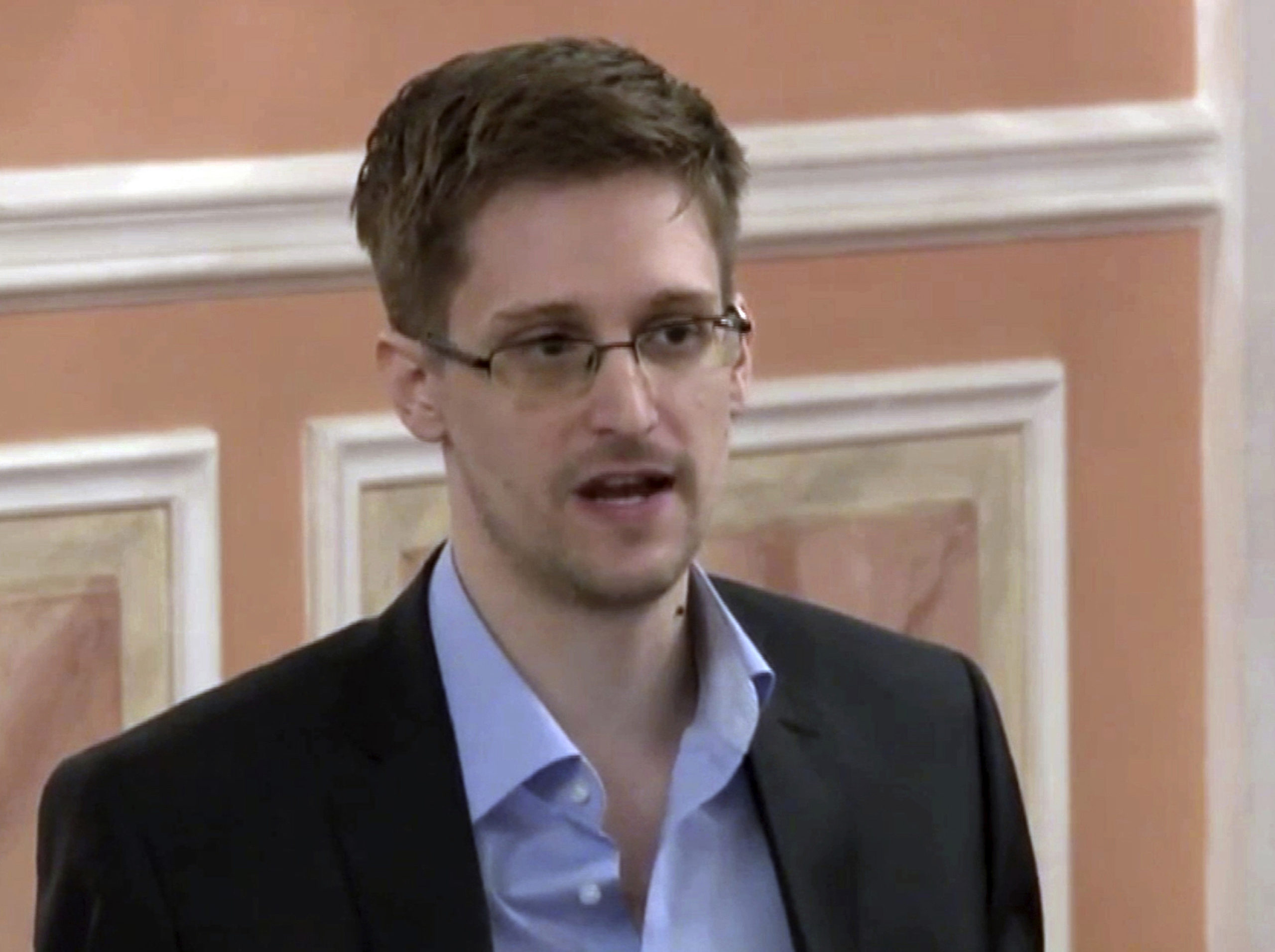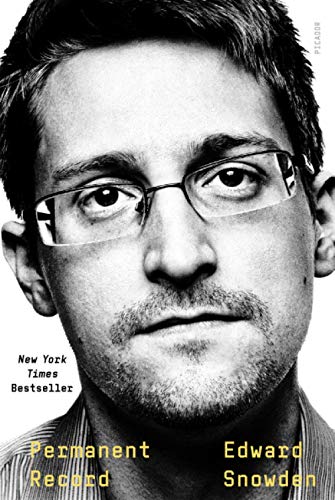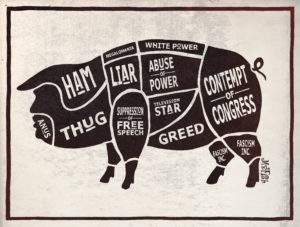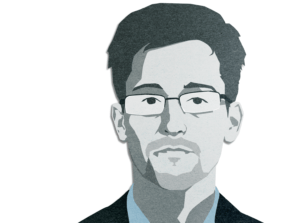Edward Snowden Sets the Record Straight
In “Permanent Record,” the NSA whistleblower tries to convince skeptics of his motives and educate readers about mass surveillance. Edward Snowden in 2013. (AP)
Edward Snowden in 2013. (AP)
I generally care relatively little for the personal lives of people of note, but something that always nagged me just slightly about Edward Snowden’s 2013 revelations that the NSA was spying on pretty much everyone was — how angry was his girlfriend?
After all, we all knew Snowden had a girlfriend, since it didn’t take long for the media to uncover that her name was Lindsay Mills, that (much to their infinite delight) she had photos of herself in lingerie, and that her significant other had suddenly turned up in Hong Kong halfway through a “business trip” and started to fill the world in on U.S. mass surveillance without running it by her first.
It must have been quite the shock.
I therefore found it uncharacteristically satisfying that “Permanent Record” included a chapter composed of extracts from Lindsay Mills’ diary. It was genuinely interesting to get an insight into how someone might cope with this very unusual situation being thrust upon them in a more candid tone than we generally get from the guarded Snowden throughout the rest of the book. These excerpts were all the more necessary, as this really is a book about the personal — no further details of public significance are released in this title, which is a work primarily of analysis and reflection.
Click here to read long excerpts from “Permanent Record” at Google Books.
The general schema of the book is precisely what one might expect: Snowden’s childhood in North Carolina and the D.C. Beltway; his decision to enlist in the U.S. Army following 9/11; his roles as a defense contractor in the United States, Switzerland, and Japan; his ultimate decision to blow the whistle on mass surveillance and subsequent temporary asylum in Russia.
Prior reviews have been accompanied by a few snarky remarks: The New Yorker, for example, claimed that Snowden saw the early internet as a “techno-utopia” where “boys and men” could roam free, although I cannot recall Snowden making such exclusionary gendered distinctions. Presumably it complements Malcolm Gladwell’s earlier piece on why Snowden is not comparable to Pentagon Papers leaker Daniel Ellsberg (since he is a “hacker” not a “leaker”) in flat contradiction to Ellsberg’s own defense of Snowden published in The Washington Post:
Many people compare Edward Snowden to me unfavorably for leaving the country and seeking asylum, rather than facing trial as I did. I don’t agree. The country I stayed in was a different America, a long time ago. […] Snowden believes that he has done nothing wrong. I agree wholeheartedly.
So eager has everyone been to snipe and show their moral fiber as good little citizens, that they have rarely found the time to dig into the main themes of “Permanent Record.” Rather than spilling more facts, Snowden’s aim seems to have been to contextualize his previous disclosures and explain their significance. Thus, while many parts of the book are truly gripping — a goodly portion of it details how Snowden removed information detailing surveillance from his workplace “under a pineapple field” in Hawaii and arranged to share it with documentary filmmaker Laura Poitras and journalist Glenn Greenwald in Hong Kong — it is the author’s underlying themes and motivations that truly deserve our attention.
It is apparent early on that Snowden pursued two main purposes in releasing “Permanent Record”: 1) to convince skeptics that he acted for the good of the country and to defend the U.S. Constitution (indeed the book’s release was timed to coincide with Constitution Day on September 17), and 2) to educate readers about technology, or at least that part of it related to mass surveillance.
Early on, while still describing his ’80s childhood and initial fascination with what he then termed “Big Masheens,” Snowden recalls imbibing lessons from his Coast Guard father Lonnie about the potential for technology to bring its own form of tyranny with it. According to Snowden:
To refuse to inform yourself about the basic operation and maintenance of the equipment you depended on was to passively accept that tyranny and agree to its terms: when your equipment works, you’ll work, but when your equipment breaks down you’ll break down, too. Your possessions would possess you.
Technological tyranny is a theme Snowden comes back to later in the book, reflecting on Mary Shelley’s “Frankenstein” — he was after all posted to Geneva, where part of the novel’s action is set.
That may sound a bit cliche, until you learn that Snowden’s sales partner during his time at Dell literally nicknamed the cloud system they developed for the CIA “Frankie” “because it’s a real monster.” That wasn’t just a private office joke, but how he tried to convince the agency to greenlight the project during a sales pitch. It’s these little pieces of not-exactly-earth-shattering, but still pleasantly informative detail that help the book keep ticking over and compensate for the often distant tone of its author. Snowden frequently describes his feelings, but rarely does he make the reader feel them.
Snowden also lavishes attention on explaining how he interacted with the internet as a child and teen. While many have interpreted these lengthy passages as either naïve utopianism or pathetic addiction, his point is much more important than that. I’m much of an age with Snowden and therefore remember many of the things he recalls: phreaking, personal homepages, chat rooms, and the days when you could just ask perfect strangers for advice and they’d give it to you. What I think I hadn’t fully considered before reading this book is that at least some people in this rather narrow cohort absorbed some knowledge of modern technology. Despite being nowhere near as interested in computers as Snowden (and having a positive antipathy to “Big Masheens”), I learned how to build circuits and program from Basic to Java as part of my general education. That gave me the ability to learn more later in life and to form a better (if still far from expert) understanding of the nuts and bolts of computing infrastructure.
By contrast, many people today know how to use tech, but they don’t understand it. Just like few people who use money understand economics. And just like an ability to grasp finance creates an enormous power differential, so does the ability to understand tech.
Snowden is at pains to redress this balance, methodically explaining everything from SD cards, to TOR, to smart appliances, to the difference between http and https, to the fact that when you delete a file from your computer, it doesn’t actually get deleted. He bestows the same attention to detail on these subjects as he does describing the labyrinthine relationships of his various employers and the intelligence agencies, and this clarity helps turn the book into a relatable story about issues rather than a jargon-stuffed, acronym-filled nightmare.
Only by understanding how technology works on a basic level, so argues Snowden, can journalists ask the right questions of power and regulators regulate effectively. He strengthens this case by noting examples of times when major announcements (construction of enormous data storage facilities; a CIA presentation in which the speaker literally admonished the journalists present to think about their rights) were simply ignored.
They did not make waves, Snowden thinks, because journalists and regulators simply didn’t realize the significance. There is, as he says repeatedly in the book, a lag between technology and regulation.
It is an issue that others in a position to know, like Elon Musk and Stephen Hawking, have pointed out. Everything from advances in robotic warfare to artificial intelligence to total surveillance aided by facial recognition is dismissed as alarmist until well after it is happening, when it’s then dismissed — in true “Nineteen Eighty-Four” style — with a shoulder shrug as inevitable.
And when that doesn’t happen, tech tends to be treated as an entirely new phenomenon requiring heavy-handed, and often counterproductive, regulation.
While it is entirely true that people are bullied on social media, for example, we shouldn’t forget that people were bullied in real life in the past, too. And threatened. And the victims of fraud. And defamation. And child abuse. As a result, we shouldn’t lose sight of the fact that we often do already have a well-developed arsenal of remedies that can be adjusted for the internet era without the need to jettison constitutional values in the name of protection and safety.
There are ways to apprehend criminals effectively without the “total take” of information that intelligence agencies so lazily demand. Vigilante “pedophile-hunting” groups have been quite successful in luring would-be predators to justice by posing as minors on social media sites. While it is beyond question that such activities should be left to properly trained and authorized police forces — not righteous citizens who can do as much harm as good — it does show that the “individualized” pursuit of crime can still be very effective in the social media age. Indeed, in regards to some crimes, like forms of child abuse, detection may well be easier than in earlier times with many culprits unable to resist the temptation to groom potential victims online.
Rather than veering between complacency and panic, we should be thinking about the various ways in which to update our legal framework for the modern digital age — something Snowden’s revelations about the warrantless mass surveillance programs he uncovered have given us a particular urgency to do.
The part of the law most significant to Snowden, and which he quotes in the book, is the U.S. Constitution’s Fourth Amendment, which reads:
The right of the people to be secure in their persons, houses, papers, and effects, against unreasonable searches and seizures, shall not be violated, and no Warrants shall issue, but upon probable cause, supported by Oath or affirmation, and particularly describing the place to be searched, and the persons or things to be seized.
According to Snowden, the NSA sought to circumvent the Fourth Amendment by creating a huge database of all online activity — the “permanent record” of the book’s title — ideally stored in perpetuity and which they would only “search” “when [the organization’s] analysts, not its algorithms, actively queried what had already been automatically collected.” Intelligence agencies also argued that because individuals have already given permission to third parties, particularly telecommunications companies, to host their data, that data no longer resided in the private sphere and thus “constitutional privacy” had been “forfeited.”
After all, the magic of what feels private — sitting in front of your computer or scrolling through your phone at home — can only happen by connecting to distant servers. Those who support a “living document” interpretation of the Constitution may see this as an eventual opportunity to expand the scope of the terms “papers, and effects” for the modern era, something Snowden himself suggests; originalists might argue that only a constitutional change itself can suffice to fully address privacy rights in a digital age.
Some of the actions that Snowden describes — monitoring people through their webcams in their homes via XKEYSCORE — would certainly seem like unproblematic violations if committed against US citizens or persons on US soil under present wording and interpretations. Others — like hunting through the vast reams of information we sign over to private companies — may prove more difficult. Justice Scalia, the nation’s most well-known originalist prior to his death in 2016, is alleged to have refused to be drawn on whether or not computer data was an “effect” in the sense of the Fourth Amendment at a public lecture in 2014.
In more practical terms, the Court of Appeals for the Second Circuit decided in 2015 (ACLU v. Clapper) that bulk collection was not covered by Section 215 of the Patriot Act, stating in part, “Congress cannot reasonably be said to have ratified a program of which many members of Congress — and all members of the public — were not aware,” a decision followed shortly by the passing of the USA Freedom Act, under which telecoms companies keep records that law enforcement may then request.
However, it is somewhat doubtful whether legal remedies alone will effectively stop the political-intelligence agency complex that Snowden describes so adroitly in his book. He recalls the panic he witnessed at Fort Meade and outside the Pentagon during 9/11, and later the blame as politicians emphasized the prevention of terror attacks as the standard for measuring their own competence. Intelligence agencies felt both the horror of having to develop some way to guarantee safety and the power of being able to extort huge budgets from Congress in the interests of doing so. Once an agency has the capability to engage in mass surveillance and is under significant pressure to maintain security, it’s difficult to imagine it failing to indulge regardless of legalities.
Snowden mentions encryption, SecureDrop, and the European Union’s General Data Protection Regulation (GDPR) as potential ways for citizens to uphold their own privacy, but I’m less than convinced. Encryption is not readily available to the average person working on an average budget; few people will ever have any reason to use SecureDrop, and I doubt many of the alleged positive effects of the GDPR, which has mainly led to Europeans agreeing to any and every pop-up in order to get to their content ASAP while introducing barriers to sharing and advertisement for small businesses (precisely not the threat).
In this context, perhaps the right to be forgotten (in fairness, now enshrined in Article 17 of the GDPR, although the principle derives from an earlier 2014 court case) is more relevant. After all, Snowden’s main fear is the creation of the unforgiving “permanent record,” where every mistake, minor trespass, and ill-considered comment remains preserved for all time and just waiting to be used against one. Indeed, he contrasts this with the early days of the web, where one could develop opinions freely and cast aside identities that one had outgrown. Snowden regards this freedom as pivotal to development and maturation, as we all tend to “curate” our lives over the years, forming the identity we want to have at the expense of conflicting past actions.
Despite the fact that he never made it to his intended destination — Ecuador — Snowden remains, much like Ellsberg, a powerful example of a person who blew the whistle on state abuses and not only lived to tell about it, but is living an apparently well-adjusted life. As he lets us know at the end of the book, Lindsay eventually joined him in Moscow, refrained from slapping him silly (as Snowden admits he deserved), and agreed to marry him. It’s a fitting low-key end for a book, and a story, that is more about substance than style.
This article originally appeared on the Los Angeles Review of Books.
Your support matters…Independent journalism is under threat and overshadowed by heavily funded mainstream media.
You can help level the playing field. Become a member.
Your tax-deductible contribution keeps us digging beneath the headlines to give you thought-provoking, investigative reporting and analysis that unearths what's really happening- without compromise.
Give today to support our courageous, independent journalists.









You need to be a supporter to comment.
There are currently no responses to this article.
Be the first to respond.